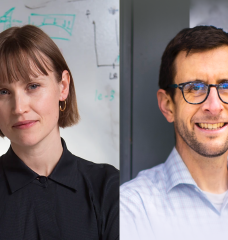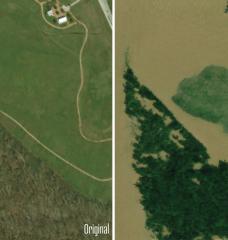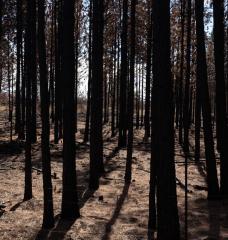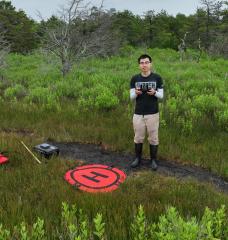
Concurrent extreme climate events can amount to a challenging 'two-fer' or even a 'three-fer' in terms of adverse impacts.
By Gary Yohe, Henry Jacoby, and Richard Richels | Friday, October 9, 2020
Reposted from Yale Climate Connections
Wildfires in California, Oregon, and Washington are this year’s poster children for extreme natural disasters. Hardly a day passed in August and September without disturbing pictures of heart-wrenching damages and loss of life. Even worse, this summer’s hurricanes became major flooding events as the storms themselves stalled over populated areas along the Gulf coast.
That does not mean, of course, that all see climate change as playing a significant role in determining the strength, frequency, or behavior of either of these climate risks.
What it does mean is that the scientific community must explain more clearly why the recent spate of extraordinary natural disasters can be understood only with reference both to impacts of climate change as we have come to know them, and now something more complex: concurrent impacts amplifying themselves in real time
Figure 2 of our September 18th essay in this series showed how global warming can push aspects of the environment toward greater extremes and higher damages. More specifically, it teaches us how trends that increase damages can, over time, make high-damage futures more likely while reducing the chances of more benign possibilities.
Recent events have taught us more than that, though. They have demonstrated a troubling propensity for several climate change impacts to show up at the same place at the same time, feeding on each other, combining forces and leading to still greater extremes. To be clear, they do not necessarily arrive at the same time and/or leave at the same time; but they do spend a significant amount of time together compounding their extreme impacts on a specific location.
The California fires are a perfect example of this phenomenon. Only three of the state’s largest 20 fires (in terms of acres burned) had burned prior to 2000, but nine of the biggest 10 have occurred since 2012. That is, extremes are becoming more likely. And they are growing larger too. In 2017, 9,270 fires burned a record 1.5 million acres. The Mendocino Complex fire the next year became the “largest wildfire in California history.” And soon came 2020.
A new largest fire in California history, the Complex fire, got started in August 2020. Soon came the 3rd, 4th, 5th, and 6th largest in history. By October 3, these five conflagrations had combined with nearly 8,000 other more “ordinary” fires to kill 31 people and burn more than four-million acres, and, on that day, all five of those fires were still burning.
Why is this happening? Wildfire is a natural part of the forest environment. But by the early 1950s, these fires were causing sufficient damage with sufficient frequency to provoke efforts to reduce what was seen as the main cause, human behavior. “Only you can prevent forest fires” was the mantra of the times.
Only a few decades later, however, changes in the climate had begun to contribute to increased fire risk. More intense droughts played a role in some years, as did extra strong heat waves. Also, milder winter temperatures were fostering the expansion of a major forest pest, the Pine Bark Beetle, which was killing large areas of forest and thereby further increasing the supply of ready fuel.
Of course, part of the increased fire risk is still the result of human actions. Damage to life and property has increased markedly as more people have moved into vulnerable forested areas, and more people in the woods means more inadvertent blazes. Changes in forest management contributed, too, because fire suppression policies on federal land reduced the brush-clearing value of deliberately set control blazes (sometimes known as “good fires”).
But these non-climate causes of increased fire danger have not increased so much over the decades to account for the devastation of the last few years. There is more to explain, and it comes in understanding how, in responding to rising global temperatures, nature can produce “2-fer” or even “3-fer” combinations of influences on local environmental conditions.
The western U.S. is, unfortunately, a clear example of this effect. Many of the fires were caused by literally thousands of dry lightning strikes. These strikes aren’t the result solely of climate change, but it is clear that they fed into a witches’ brew of conditions that are all linked to global warming:
1. the lightning strikes and other points of ignition in the midst of a record drought;
2. record heat for days on end in July and August;
3. infestations of bark beetles producing large stands of dead trees; and
4. decades of gradual warming extending the western fire season by some 75 days.
Taken together, these contemporaneous impacts make it clear that the issue is not just what sparks the fires. The larger problem is the context in which they start, and how quickly they spread once started, especially when several intensifying influences are also present.

A similar story can also be told about damages from tropical storms. As shown in Figure 1, hurricanes Harvey and Florence dropped historic amounts of rain after making landfall and then stalling over Houston and New Orleans, respectively. This summer, hurricanes Laura and Beta followed suit and dumped extreme rainfall totals and caused substantial damage from storm surge.
Multiple extreme climate events mean bad news - a ‘two-fer’ or even a ‘three-fer’ in terms of catastrophic damages.CLICK TO TWEET
Here is another example of a climate change induced compound effect – a “3-fer”:
1. Near record-warm ocean temperatures allowed many tropical depressions and non-tropical low pressure systems to develop into dangerous hurricanes;
2. A decrease in the summer temperature difference between the Arctic and the tropics that is strongly suspected to have weakened atmospheric steering currents and created more slowly moving storms.
3. Sea-level rise, one of the most obvious results of decades of rising temperatures, compounded risks posed by storm surge.
The expanding consequences of compound fire and flood events are also getting harder to control and survive. For example, many of the worst fires and hurricanes have exploded so quickly and spread so erratically that human evacuations have become “moment’s notice” emergencies. Just as with residents of the southeastern and Gulf coasts, residents from California and Oregon must retreat from harm’s way as quickly as possible, and hope that conditions will soon change back to something more benign.
Over time, the weather eventually becomes more favorable. Unfortunately, the climate is not going to change back to what used to be, certainly not on a human time scale. So, when they have a chance, perhaps vulnerable residents should just try to move as far from harm’s way as possible.
That might be a good idea for the short-run, but lest we forget: None of us can move to a different planet.
Gary Yohe is the Huffington Foundation Professor of Economics and Environmental Studies, Emeritus, at Wesleyan University in Connecticut. He served as convening lead author for multiple chapters and the Synthesis Report for the IPCC from 1990 through 2014 and was vice-chair of the Third U.S. National Climate Assessment.
Henry Jacoby is the William F. Pounds Professor of Management, Emeritus, in the MIT Sloan School of Management and former co-director of the MIT Joint Program on the Science and Policy of Global Change, which is focused on the integration of the natural and social sciences and policy analysis in application to the threat of global climate.
Richard Richels directed climate change research at the Electric Power Research Institute (EPRI). He served as lead author for multiple chapters of the IPCC in the areas of mitigation, impacts and adaptation from 1992 through 2014. He also served on the National Assessment Synthesis Team for the first U.S. National Climate Assessment.
Photo: Napa Valley vineyards engulfed by wildfire during extreme heat and severe drought. (Source: Yale Climate Connections)






